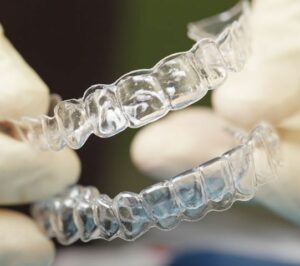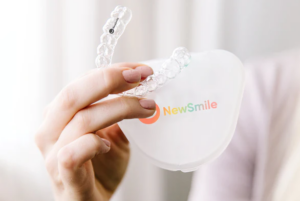Aligner fit is crucial for straight teeth and a happy smile. It’s not just about looking good. It’s about achieving comfort and health from your orthodontic journey. A study published in The Angle Orthodontist, comparing two transparent aligner brands, highlights the profound impact of aligner material and fit on treatment success.
The custom trays should fit your teeth really well. A precise fit of the transparent aligners means predictable, comfortable teeth movement, leading to the straight, confident smile you deserve.
Explore the significance of the optimal aligner fit in this blog.
Table of Contents:
Essential Aligner Fit Criteria
Customization for dental arches involves personalized aligners snugly wrapping teeth for comfort and effectiveness. At the same time, seamlessness is key, integrating aligners into daily life with minimal disruption.
Notably, Byte and similar clear aligners offer a discreet option, allowing removal for daily activities. In order to make aligners work optimally, regular check-ups ensure a snug fit and the application of necessary forces for desired tooth movements. A personalized approach maintains the efficacy of the treatment throughout the process.
Causes of Poor Tracking in Aligners
Tracking is like a progress report in the clear aligner world. It tells you if your aligners are hugging your teeth tightly enough to guide them in the right direction. Precise tracking of your aligners for overbite or underbite correction, spacing, crowding, or other dental issues is crucial.
Various factors contribute to poor tracking in aligners, including improper aligner fit, inconsistent wear, and other elements influencing the alignment process. Cracked or chipped aligners can rub against your gums and inner cheeks, causing aligners pain.
An improper fit may result from prematurely switching trays, inadequate wear duration, or misplacement. Inconsistent wear, not adhering to the recommended 20-22 hours per day, can also hinder the desired outcome.
Two Most Common Aligner Fitting Problems + Easy Solution
Sticking to the recommended 20-22 hours of daily wear is crucial for preventing discomfort and fit problems. Consistent wear allows your teeth to gradually adjust to each aligner, minimizing friction and promoting a smooth treatment experience. If issues persist, consult for adjustments or new aligners.
For discomfort, you can consider over-the-counter pain relief, orthodontic wax, and gradually increasing aligner wear time. If problems persist, seek guidance from your orthodontist. They may suggest solutions like adjusting, trimming, or providing a new set of aligners for a more comfortable and effective teeth-straightening journey.
Following are the common fit issues patients could face with aligners.
Aligners Not Fitting Back Teeth
Sometimes, your aligners might not fully sit on your back teeth due to tight spaces between your back teeth, worn-out aligners, or a lack of space between your back teeth. All of these can make it challenging for the aligner to slide into place.
This issue can impact your treatment by slowing down the movement of your back teeth, potentially delaying the overall progress of your treatment. Misaligned back teeth can disrupt the aligner’s fit for other teeth, causing potential tracking issues.
To address these concerns, consider incorporating chewing exercises to strengthen jaw muscles, aiding the aligner in sitting better on your back teeth. Consistent wear is crucial, especially for challenging areas.
Aligners don’t Fit on One Side
Cramped teeth on one side create difficulty for the aligner to fit well. Limited space between teeth can impede their intended movement, resulting in a snug aligner fit. Teeth not tracking properly on one side might slow down your progress, causing overall tracking issues when one side misaligns.
To address this concern, engage in chewing exercises for stronger jaw muscles and a better fit. Consistently wear your aligners, especially for stubborn areas. If issues persist, consult your orthodontist for potential adjustments or alternative solutions. Using Invisalign chewies on the misaligned side can also apply pressure and improve the fit.
Our Recommended Product to Forget Your Problems
If you are tired of aligner fit struggles, ditch the discomfort and tracking troubles with Byte! Byte’s innovative aligners offer a smooth, comfortable journey to your dream smile.

The most efficient at-home teeth straightening solution you can get in the US.
- Short treatment time
- High-quality materials
- HyperByte technology
- Flexible financing options

Your best bet to save money while receiving high-quality aligners.
- Affordable pricing
- Great payment options
- Comfortable
- Effective for various dental conditions

Top-notch remote orthodontic service optimized for avoiding lengthy in-office visits.
- Best remote experience
- Great for mild-to-moderate misalignments
- Fits different gum lines well
- Board-certified dentists and orthodontists
Why Byte is different?
Precision fit: Custom-made trays hug your teeth like a friend, ensuring optimal tooth movement and minimal fuss.
Comfort is key: Say goodbye to soreness and irritation. Byte’s smooth edges and flexible material feel gentle on your teeth and gums.
Faster results: Get straighter teeth faster with Byte’s efficient treatment plans. You’ll be flashing your new smile sooner than you think!
But don’t just take our word for it. Discover the Byte difference for yourself! Click the link to learn how does Byte work, and why it’s the perfect solution for your aligner fit problems.
How Do I Make My Aligners Fit Better?
Let’s explore effective strategies to ensure your aligners fit better and contribute to a successful orthodontic experience.
Adhere to Consistent Wear
To achieve an optimal fit, commit to the recommended wear time of 20-22 hours daily. Skipping hours can disrupt tooth movement and compromise the aligner fit. Sticking to the prescribed wear time ensures steady progress and maximizes the effectiveness of your clear aligners in achieving the desired results.
Practice Good Oral Hygiene
Maintaining excellent oral hygiene plays a crucial role in optimizing aligner fit. Clean teeth and aligners contribute to a snug fit and ensure effective tooth movement. Regular brushing and flossing prevent bacterial buildup, reducing the risk of irritation or discomfort.
Avoid Warping or Distortion
Safeguard your aligners from warping or distortion by steering clear of heat exposure. Keep them away from hot water, sunlight, or dishwashers, as high temperatures can compromise the material, impacting both fit and effectiveness.
Protect your orthodontic investment by following this advice, ensuring your aligners maintain their integrity and continue to guide your teeth effectively for a successful and comfortable treatment journey.
Regularly Clean Aligners
Elevate your aligner care routine for optimal results. Rinse your aligners with lukewarm water after each meal or drink, especially if it involves sugary or staining beverages. Additionally, invest in an aligner cleaning solution to ensure thorough disinfection.
This diligent approach preserves the transparency of your aligners, enhances comfort, and contributes to a hygienic orthodontic experience, promoting both the longevity and effectiveness of your aligners throughout your treatment journey.
Check for Wear Compliance
Stay vigilant about wear compliance for effective aligner use. Pay attention to how your aligners feel – if they slip easily or show gaps around certain teeth, report these concerns to your orthodontist immediately.
Early detection of any poor fit issues is crucial, allowing for timely adjustments to maintain the effectiveness of your treatment and ensure a comfortable orthodontic journey.
Avoid Eating with Aligners
Eating or drinking anything but water with your aligners can damage them and trap food particles, leading to discomfort and bacteria growth. Enjoy food breaks for a happy mouth and happy aligners.
Use Orthodontic Wax for Discomfort
Ease discomfort during your orthodontic journey by utilizing orthodontic wax. It can help deal with rough or irritating spots on your aligners that affect your gums. This simple solution creates a smooth barrier, alleviating soreness and ensuring a more comfortable experience throughout your treatment.
Stay Hydrated
Adequate water intake promotes saliva flow, maintaining a clean mouth and ensuring a snug fit for your aligners. Aim for a daily intake of eight glasses of water to enhance comfort and support overall oral health throughout your orthodontic journey.
Seek Prompt Professional Help
Don’t hesitate to contact your orthodontist if you experience any persistent discomfort, difficulty with fit, or concerns about your progress. Prompt professional help can address problems before they escalate.
Conclusion: Impact on Treatment Effectiveness
Poor tracking aligners can be caused by a suboptimal fit. It significantly hinders the overall effectiveness of treatment, especially impacting the aligners treatment duration required to achieve teeth alignment goals. When teeth don’t track correctly, it can lead to setbacks, causing delays in reaching the intended results.

